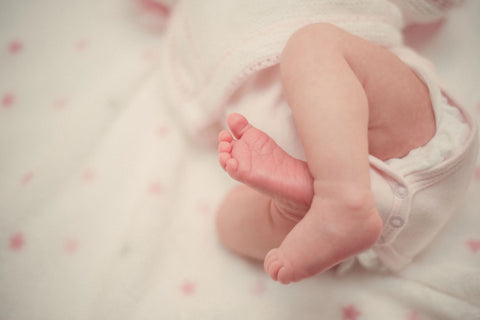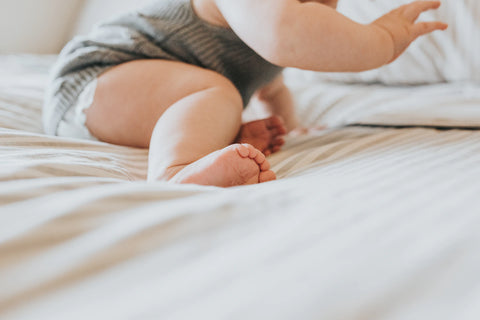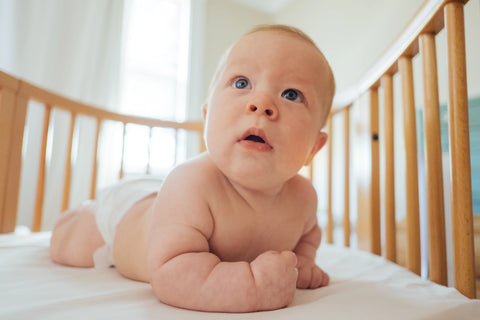Disposable nappy or Cloth Diapers: How do I Choose?
•Posted on December 09 2022

Have you calculated how many diapers you need to raise a child? If you try to stop using diapers from the age of 2, you'll need about 4,000 diapers, not counting the additional amount needed for special cases such as lactose intolerance and diarrhea.
| Age | 1-3M | 3-6M | 6M+ |
| Daily use | 8PCS+ | 6-7PCS | 5-6PCS |
Diapers should not be taken off too early. At 18 months of age babies will start to indicate that they have urination and defecation, we can give more guidance and exercise to choose a suitable and fixed position for urination and defecation, so as to lay a good foundation for taking off diapers. Before that, because of the young age can not control their own urination, if prematurely do not use diapers will in disturb the baby play, affect the development of concentration; even affect the sleep, is not conducive to rest, and affect the secretion of growth hormone.
So, how do we choose safe diapers? How do we determine which is better for our children, diapers or cloth diapers? How often are diapers changed? Keep reading and let's find the answers together.
Table of Content:
- Selection for different age groups
- Size is important
- Choice of different materials: disposable nappy vs. cloth diapers
- Proper care for diaper changing
Selection for different age groups
Choosing a good quality and suitable diaper is very important for both parents and babies, because it is not only a "good helper" for parents, but also a "close partner" for babies. Therefore, in addition to the reference value of weight, parents also need to pay attention to the physiological characteristics of the baby's current growth period when buying diapers.
Newborn (0-5Months)
The little baby just born during 0-5 months has relatively low mobility, so comfort and softness become the primary consideration for parents to choose diapers. Newborn baby diapers require: light and breathable.
Parents must change diapers and thoroughly absorb moisture from the buttocks with paper towels after the baby has defecated in order to effectively avoid red buttocks and diaper rash. However, many newborns defecate irregularly, which makes it difficult for new parents to keep track. Therefore, when choosing diapers, it is important to not only focus on thickness and absorbency strength, but also to choose light and breathable diapers for your baby according to your baby's skin and seasonal characteristics.

Learning to crawl (6-12Months)
As the baby grows, the range of motion increases. He learns to sit alone, leaning forward and wanting to play with the toys that get into our hands. At this point, we have to consider changing to a diaper that is more suitable for him. This is the time to choose diapers with more focus on:
1. Leakage prevention
Babies are more active, so if the diapers are not leak-proof and not properly worn, they are likely to leak during the activity. Choosing diapers that fit the baby's body shape can effectively reduce the generation of leakage.
2. Flexible Velcro does not hurt the skin
The flexible Velcro is convenient for parents to adjust the elasticity of the baby's waistline at will and can be repeatedly adhered without hurting the skin. What your baby needs during this period is a diaper that fits well so that he can move around more freely.
Toddler (After 13 Months)
As your baby takes his first steps into the world, it shows that he is maturing in independence and self-awareness. Bulky diapers can seriously affect your baby's movement, and those that are too small or too tight are also likely to wear down the skin on the inner thighs. During this period, parents should give more consideration to the design and cut of the diaper when choosing a diaper. Use a U-shaped cut that conforms to ergonomics; or choose a style designed as a small panty that is easy for the baby to wear.
Size is important
How important is it to choose the right diaper size? If the size is large, it is easy to side or rear leakage; if you choose small, not only the baby's waist and legs are prone to strangulation, but also the diaper's ability to absorb urine is insufficient, which can cause rashes.
However, since the size requirements of each diaper brand in the market vary, we need to take measurements when shopping. Take into account your child's weight and waist circumference to choose. When measuring the waist circumference, you can put a finger on the pad and measure around the belly button for a week. For babies with more flesh on their hips and thighs, you can also add hip and leg circumference measurements.
Choice of different materials: disposable nappy vs. cloth diapers
There are two main types of diaper materials: disposable nappy and cloth diapers, both of which have their own advantages and disadvantages.
Disposable nappy
Disposable nappy are disposable products, and their introduction has greatly freed parents' hands and reduced the burden of care, without spending too much energy on changing, cleaning and disinfection. The common materials of diapers are mainly non-woven fabric, infusion layer, toilet paper, polymer absorbent material, breathable bottom film, adhesive patch, waist elasticity, etc.
Advantages
- Very easy to use, with special time saving by using up and throwing away.
- The special surface of the disposable nappy allows the baby's skin to be free from urine soaking and the diaper's ability to absorb and shrink water is better than cloth diapers.
Disadvantages
- Expensive: Parents who use a lot of diapers every day know that diapers cost a lot of money every month, and they are probably the second largest expense after milk powder.
- Not environmentally friendly: diapers are all disposable items, and throwing them away after use will generate a lot of solid waste, which is really bad for the environment.
- Skin irritation: diapers are not all natural, and although they have been developed and improved over a long period of time, they still inevitably irritate babies' skin, and sensitive babies can develop rashes.

Cloth diapers
The main material of traditional cloth diapers is cotton, which has better absorbency and breathability; the material is easy to source, and the traditional method is to make them from old clothes and bed sheets, which can be used repeatedly and economically. At present, there are also diapers made of cotton medical gauze sold in the market, which has stronger water absorption. We can look for children's clothing wholesalers and also find wholesale cloth diapers at good prices.
Advantages
- Saving money: cloth diapers are recycled and can save big money every month.
- Soft and skin-friendly: all diapers for babies should be made of cotton fabric, which is soft and skin-friendly.
- Environmentally friendly: although the constant washing of diapers costs water, the recycling of cloth diapers still makes it very environmentally friendly.
Disadvantages
- Time-consuming and labor-intensive: each time they are used, they have to be washed and dried, increasing the amount of labor, which is the most important reason why cloth diapers are replaced by diapers.
- Poor water absorption and water locking: Cloth diapers have almost no water locking ability and need to be changed immediately after the baby wets, and they tend to soak the baby's clothes.
Cloth diapers and disposable diapers have their own advantages and disadvantages, there is no absolute who is better and who is worse, they can both be used for babies. Parents can decide which one to choose based on their own preferences and family situation with a full understanding of the two types of diapers, or use both types of diapers together, such as cloth diapers during the day and diapers at night.
Tips:
- Diapers should be of good absorbency and breathability, and the right size should be bought.
- Cloth diapers should be made of soft, absorbent and washable cotton fabric, while their color should preferably be light, so that abnormalities in the color of the baby's urine and stool can be detected in time.

Proper care for diaper changing
Regardless of which diapers we choose, we all need to learn about diaper changing care:
- Diligent replacement: as long as the baby defecates, it should be replaced in a timely manner; conditions do not allow, you need to ensure that each defecation immediately after the replacement, urination up to 2 times after the replacement.
- Gently clean: Before each change, gently wipe with water or wet cotton towels, and then gently absorb the water with soft tissue or dry cotton towels, never "violently" wipe with rough tissue.
- Reduce stimulation: ensure that your baby's buttocks are in a completely dry state, apply buttock cream and then wear diapers to isolate diapers, excrement and skin to avoid irritation.
Parents want to give their children the best, but there is no such thing as the best fit in this world. Follow up on your own needs and take your time to search and explore before you find the right diaper for your child.
More Posts
-
Night Sweats During...
Women are prone to night sweats in early pregnancy, which varies from person to person and may last up to a month after delivery before ending.Befo...
Read More -
Feeding Your Baby w...
When you have a baby, a bottle is definitely indispensable. Whether it is mixed feeding, formula feeding, or breastfeeding bottle feeding, the heal...
Read More -
Disposable nappy or...
Have you calculated how many diapers you need to raise a child? If you try to stop using diapers from the age of 2, you'll need about 4,000 diapers...
Read More


Comments
0 Comments
Leave a Comment